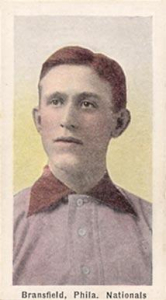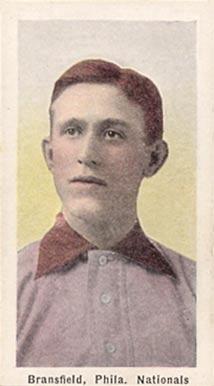Kitty Bransfield
 A smooth-fielding, hard-hitting first baseman, Kitty Bransfield helped form the nucleus of the juggernaut Pittsburgh Pirates that dominated the National League from 1901 to 1903. Yet in the great tradition of baseball superstitions, his departure from Pittsburgh after a dismal 1904 season left such a void that the club’s decades-long quest for another adequate first sacker became known as “The Bransfield Curse.” Bransfield revived his career in Philadelphia; in his book The National Game, published in 1910, Alfred H. Spink described the big first baseman of the Quakers as “something unusual—a player who was almost all in and then came back stronger than ever.” The lifetime .270 hitter remained with the Phillies through 1911, becoming (according to Spink) “probably the most popular player in the National League.”
A smooth-fielding, hard-hitting first baseman, Kitty Bransfield helped form the nucleus of the juggernaut Pittsburgh Pirates that dominated the National League from 1901 to 1903. Yet in the great tradition of baseball superstitions, his departure from Pittsburgh after a dismal 1904 season left such a void that the club’s decades-long quest for another adequate first sacker became known as “The Bransfield Curse.” Bransfield revived his career in Philadelphia; in his book The National Game, published in 1910, Alfred H. Spink described the big first baseman of the Quakers as “something unusual—a player who was almost all in and then came back stronger than ever.” The lifetime .270 hitter remained with the Phillies through 1911, becoming (according to Spink) “probably the most popular player in the National League.”
William Edward Bransfield was born on January 7, 1875, in Worcester, Massachusetts, and he would spend most of his life in that baseball-crazed city. His original nickname was “Kid,” but a reporter with bad hearing heard it as “Kitty” and the name stuck.
Bransfield began his career in baseball as an outfielder with shop teams in Worcester. In 1894 he went behind the bat, and the following year he received a tryout with the professional team in Pawtucket. Found wanting, Kitty returned to the Worcester area and played for strong semipro teams in Westboro and Grafton. In 1898 the 23-year-old backstop received another professional trial, this time with the National League’s Boston Beaneaters. Already well-stocked at catcher with the talented (albeit volatile) Marty Bergen, the Beaneaters looked Kitty over for five games and released him to Worcester’s minor league team. After spending the 1899 season behind the plate, the 5’11”, 207 lb. Bransfield switched to first base in 1900 and led the Eastern League in hitting with a .371 average.
With the death of Tom O’Brien and the poor performance of Duff Cooley, the Pittsburgh Pirates desperately sought a new first baseman for the 1901 season. Bransfield, whom they acquired in a straight sale from Worcester, proved to be exactly what they needed. As the Pirates walked away with their first NL pennant by 7½ games over the second-place Phillies, Kitty batted .295 in 139 games and established career highs in runs (92) and RBIs (91). The 26-year-old rookie was no slouch on defense, either, even though his playing style at first base was unusual for the Deadball Era. In a time when bunting was a major part of the game, Bransfield played back on the grass, so deep that he claimed he never saw shortstop Honus Wagner make more than a handful of great plays. “He would cut that ball loose for the bag, and I had to be there,” Kitty remembered. “So whenever it was hit his way I was digging for the bag. I knew he would have it there, and I had to arrive as soon as the ball. I never had time to watch him field it. But if you want me to make an affidavit that he was the greatest ball player that ever lived, I’ll gladly do it.”
Though he batted a career-high .305 during his sophomore season, Bransfield never quite fulfilled the promise of his rookie season with Pittsburgh. His average fell to .265 in 1903, and his poor hitting in the first-ever World Series that year hinted that his days in the Steel City were numbered. In 1904 Bransfield became mired in a physical and mental slump, his batting average plummeting to an anemic .223. Prior to the 1905 season, Pirates owner Barney Dreyfuss shipped him to the Philadelphia Phillies along with Otto Krueger and Moose McCormick for minor-league phenom Del Howard. It turned out to be one of the worst moves in Pirates history. No fewer than 25 different players, including the immortal Wagner, tried their hand at the initial post for the Pirates from 1905 to 1920. In 1908 four different players auditioned and were found wanting. Though some claimed that Charlie Grimm finally ended what became known as “The Bransfield Curse” when he took over the position for Pittsburgh in 1920, others believe that it wasn’t laid to rest until the arrival of Willie Stargell a half-century later.
The move to Philadelphia did wonders for Kitty Bransfield. From 1905 through 1910 he anchored a rock-solid defensive infield that eventually included Otto Knabe and Mickey Doolan at second and short, respectively, and Harvard Eddie Grant at third. Though known more for his glove than his bat, Bransfield in his best years was an above-average hitter during a time when good hitters were scarce. His finest year with the Phillies was 1908 when he led the team with three home runs, 71 RBIs, and a .304 batting average, becoming one of only five .300 hitters in the National League that season.
Off the field, Kitty developed a reputation as a man of integrity. Years after the 1919 Black Sox scandal, teammate Red Dooin recalled an incident at the Polo Grounds during the 1908 pennant race, when gamblers tried to persuade the Phillies to drop games to the Giants. “Why gamblers opened up a satchel, must’ve had over $150,000 in it, told our pitchers to help themselves,” Dooin recalled. “At the first game at the Polo Grounds, a big man handed me $8,000, told me there was $40,000 more waiting for me. I called big Kitty Bransfield, who threw him down the stairs.” Dooin and Bransfield figured in another story about gamblers, this one in the City of Brotherly Love. Both were called to a house on Columbia Avenue. When they realized their hosts were gamblers, the story goes that Dooin threw the pair of sports down one flight of stairs and Bransfield finished the job, transporting them to street level.
Twenty-five-year-old Fred Luderus took over at first base for the Phillies in 1911, making Bransfield expendable. That September the 36-year-old veteran became a Chicago Cub, and his three-game stint filling in for the ailing Frank Chance marked the end of his major-league career. In 1912 Bransfield attempted to hook on with Louisville but was released to Montreal, where he succeeded Chick Gandil at first base and became player-manager later that season. He failed to make winners out of the Royals, however, and was fired in the middle of the 1914 season.
Bransfield spent the rest of 1914 and all of 1915 as an umpire in the New England League. The International League was his next stop, and in 1917 he became a National League umpire. His tenure lasted only one year, however, and in 1918 he rejoined the New England League, where he umpired through the 1921 season. Bransfield returned to the big leagues in 1922 as a scout for the Cubs. In 1924 he took the managerial reins one last time, leading Waterbury of the Eastern League to a pennant. He remained with Waterbury for the 1925 and 1926 seasons and then skippered the Hartford Senators in 1927 before leaving baseball for good.
In 1934 Kitty became supervisor of public playgrounds in his native Worcester, and he later worked as a night watchman for the Parker Manufacturing Company. During the last years of his life he remained an active observer of the baseball scene, always noting that he had not seen any player who could compare to Wagner. Kitty Bransfield died in Worcester at age 72 in 1947.
Last updated: August 9, 2020.
Note: A slightly different version of this biography appeared in Tom Simon, ed., Deadball Stars of the National League (Washington, D.C.: Brassey’s, Inc., 2004).
Sources
For this biography, the author used a number of contemporary sources, especially those found in the subject’s file at the National Baseball Hall of Fame Library.
Full Name
William Edward Bransfield
Born
January 7, 1875 at Worcester, MA (USA)
Died
May 1, 1947 at Worcester, MA (USA)
If you can help us improve this player’s biography, contact us.


